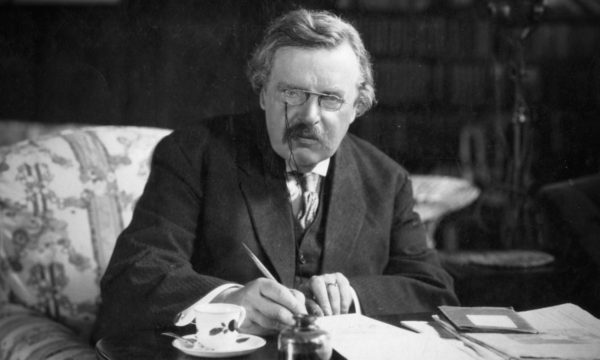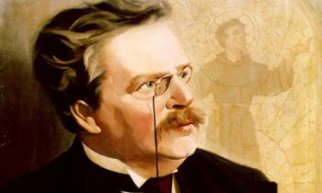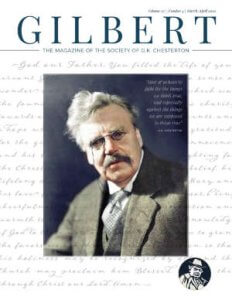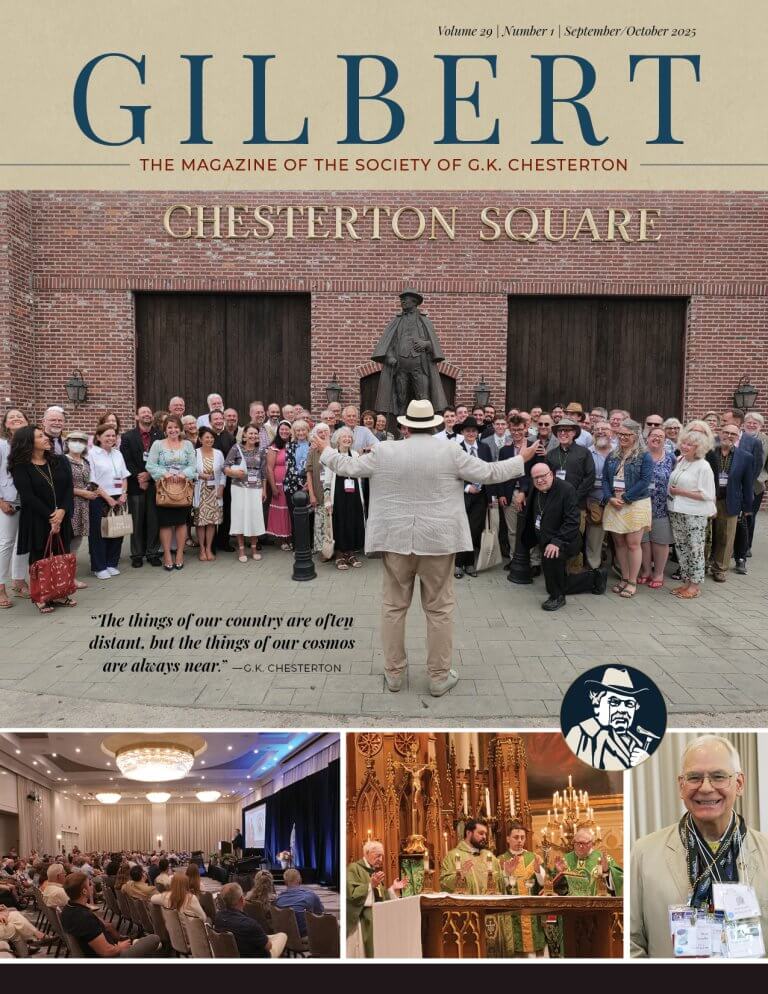Zach Summers is Headmaster of Chesterton Academy of St. Margaret Clitherow in Knoxville, Tennessee.
Even more difficult than opening a classical Catholic school in East Tennessee is opening a Chesterton Academy, for the mere reason that no one here knows who G.K. Chesterton is. The Appalachians are full of committed Catholics, but few have heard of the surplus English essayist, journalist, novelist, and Catholic convert. Even then, those who are on our side fail to understand how he inspired an entire schools network, why we picked him over so many saints, and why we should be invoking his intercession in our daily prayers.
Several parents, all faithful Catholics, knowing my affinity for the Dominicans, have asked gently, “Why not St. Thomas Aquinas?” These questions are not malicious, but come from confusion and concern. Our mascot may as well be an old man at a typewriter smoking a cigar.
At some point, arguments fall short. From the wisdom of Fulton Sheen, “Testimony does best,” combined with beauty.
When visitors arrive to campus, they’re first struck by our yard sign with a profile of what looks like Winston Churchill staring out at the rising sun. The image itself seems very out of place in today’s age, a sign of the “patriarchy” and everything that we’re trying to “progress out of” (words used by one visitor).
As you enter our unassuming Little Blue School (ironically, previously a chiropractor’s office, setting things straight), you walk past the school photos of the bishop and the pope, as beeswax and incense still lingers in the air from the morning Mass, and you are met at the front desk by our secretary. After having signed in, you stand idle in the lobby waiting to be received, as the secretary gets your staff member. Somewhere a bell rings and a student rushes by with a well-worn copy of Henle’s Latin as a group of upperclassmen dramatically recite the Invocation to the Muses out loud for the umpteenth time on the way to their lockers. You begin to feel that you have stepped out of your own world and into a new one, both familiar and foreign. A world that runs parallel to your own and maybe was even there before yours began. Another bell rings, and doors are shut as quickly as they were opened, as classes pray and begin their studies, whilst the straggling student tries to slip into class in the middle of prayer unnoticed by the teacher.
Fat men. Prayer. Latin. Greek gods. Chants willingly and enthusiastically recited by normal kids. Kids that can be late. What is this place?
“The world will never starve for want of wonders; but only for want of wonder.”
Your mind has been dislodged. You reset and look about the lobby still waiting to be received. At first, your eye is drawn across the rather busy front desk and then to the left to the beautiful chapel. But ultimately you stand in the lobby gazing out the window, at the statues of saints, our small little gift shop, and then to the corner.
Tucked away in the corner rather unassumingly is a picture frame matted with blue and trimmed with gold, evoking the school colors. You notice an article, but immediately above the article is a little sketch roughly hewn. In this sketch is a cabman, and your eye can’t help but notice that it looks like the fat man on the sign. You stare intently for a few minutes at the image, and your eyes begin to scroll down to the article, “The Extraordinary Cab Man.”
You are immediately swept away, willingly or forcefully, by the purple prose of the author leading you through a rather colorful and interesting story that started off with some intellectual argument but immediately dove into storytelling. You know the author is getting somewhere, but he clearly seems to not be in a hurry, taking his time. By the time you get to the end of the article, you see his point – the point of asserting yourself and not doubting yourself even by the most earnest of cabmen.
Finally, your eye is drawn back up to what at first seemed the least interesting part of the entire frame: the faded green rectangle that the initial sketch originally came in. The very handwriting and signature of G.K. Chesterton. In one fell swoop, you have come to know the man you had previously just regarded as the Fat White Man on the Sign. And even if you still don’t agree with him or even entirely with the school, you come to know the school better now. No argument won you into this school. No one tried to give you a history about who G.K. Chesterton is. Rather, an encounter.
You are first pulled into the scene by beauty, the via pulchritudinous, seeing the beautiful blue and gold frame, then the intriguing visual illustration, finally to the beauty of words, and then to the point, and finally to the man himself and his signature. This is the way of encountering Chesterton, I think: through witness, through experience, and lastly through argument.
The path to truth is not through arguments but through encounter. Chesterton got this. He told stories, not sermons. We do not expect our students to memorize facts about him, but rather to encounter him the same way Chesterton encountered Catholicism – through what Pope Benedict called the “spark of joy.”
This romanticized experience does not occur for all, nor is everyone who stares at this frame converted. Some scratch their heads at the frame or simply shrug their shoulders and walk away. But if they leave having at least felt a strange pinch of joy or seen that education here is more than just grades and transcripts, about the joyful formation of the soul through the good, the beautiful, and the true by way of the old books, then they have understood something essential. They at least get why we are here, and that makes all the difference.






